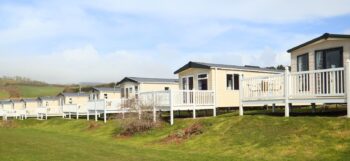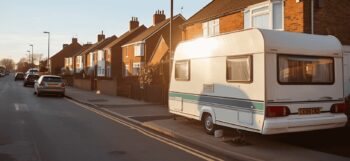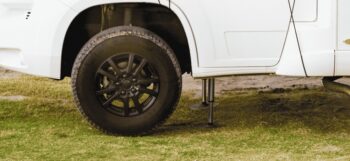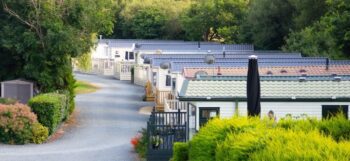In the quest for secure and comfortable living spaces, the safety of our homes remains vital.
If you’re a park homeowner, or thinking of buying a park home, you may wonder about the risk of fire, considering their unique construction and design.
In this article, we explore elements that can help to reduce the risk of fire in park homes, to offer you extra reassurance that you’re in a safe living environment.
Construction standards
Park homes undergo a fabrication process, which differs from the construction traditional bricks and mortar homes, in both materials and assembly.
Typically built in factories, park homes must adhere to the stringent British Standard BS: 3632, the specific benchmark for design and construction, emphasising fire safety measures.

These measures, in conjunction with modern construction methods, are intended to ensure that park homes are built with a strong emphasis on minimising fire risks and enhancing the safety of the occupants. Once the construction process is completed, and the park homes meet the required standards, they are then transported to their designated sites, providing residents with a living environment that prioritises fire safety.
So, what helps to reduce the risk of fire in park homes?
Materials and fire prevention
While park home construction materials may differ from that of traditional housing, the evolution of park home construction in the UK has seen a notable shift in materials and technologies employed to enhance fire safety. Historically, park home construction relied upon conventional materials such as wood, fiberglass, foam board insulation and asphalt shingles, all of which have limited fire-resistant properties.
However, advancements in technology and a heightened emphasis on safety have driven the adoption of more sophisticated strategies. Over time, the construction industry has embraced innovative solutions to mitigate these risks and prioritise the safety of park home occupants.
Modern park homes now benefit from the integration of advanced fire-resistant materials. Exterior cladding, for instance, is carefully selected for its inherent resistance to ignition and flame spread. Fire-resistant insulation materials have become standard, not only for their thermal performance but also for their ability to impede the rapid spread of fire within the structure.

Roofing materials have seen a transformation, with a shift from the use of traditional asphalt shingles towards non-combustible options such as metal, concrete, clay, and natural slate tiles. These choices not only enhance fire safety but also contribute to the overall resilience of the home against the elements.
The application of fire-retardant coatings such as intumescent paints has become more widespread. When exposed to heat, intumescent paints create a protective layer that inhibits the spread of flames and heat transfer, offering an additional safeguard.
Windows and doors in modern park homes are now designed with fire-resistant properties. These typically include fire-resistant glass designed to withstand high temperatures and intumescent strips and seals, which swell when exposed to heat to seal gaps and prevent the penetration of flames and smoke. Such improvements ensure that critical entry points can withstand exposure to flames and contribute to the containment of a fire within the structure.
Safety within the home
A critical aspect of fire safety is the implementation of preventive measures within the homes themselves. New park homes are equipped with safety features, including smoke alarms, as standard.
These devices play a pivotal role in providing early warnings, giving residents crucial time to react, especially during sleeping hours. Regular checks and maintenance of these alarms, along with the use of mains-wired systems, contribute to their reliability, reducing the chances of failure.

Comparative safety
Contrary to misconception, park homes do not pose a higher risk compared to traditional residences. The causes of fires in park homes align with those of any other dwelling, highlighting the fact that accidents and faults can happen anywhere.
The consistent adherence to construction standards, coupled with the integration of advanced safety features, positions park homes as a safe and secure housing option for those who are looking to downsize, free up some equity and embrace park home living.
Residents and those thinking of buying a park home can rest assured that their homes are built with a focus on preventing and mitigating fire risks, making park homes a potentially perfect for those seeking a safe and secure living environment.
Parkhome Insurance
Given the unique construction of park home dwellings and the specific risks associated with ownership, securing specialist insurance for your park home is of utmost importance to consider.
We’ve been supporting park homeowners with park home insurance for more than 30 years. Our specialist policy has been shaped to meet the specific needs of park homeowners, based on feedback from our customers.
Underwritten by A rated insurers* in the UK our policy include valuable features such as Legal Expenses cover and 24-hour Home Emergency as standard, so you can have the protection you may need, all in the one policy.
Our knowledgeable and friendly team can talk though the options with you, so you can build a policy that meets your requirements. Call us today on 01480 402 460 to see how we can help. Alternatively, you can get a quote and buy online though our online service.
Discover more about what’s included in our park home insurance today!
Terms and conditions, limitations, exclusions, and acceptance criteria apply. Policy enhancements are subject to an additional premium.
*Independent ratings from third party rating companies. Correct as at January 2026
Disclaimer: The sole purpose of this article is to provide guidance on the issues covered. This article is not intended to give legal advice, and, accordingly, it should not be relied upon. It should not be regarded as a comprehensive statement of the law and/or market practice in this area. We make no claims as to the completeness or accuracy of the information contained herein or in the links which were live at the date of publication. You should not act upon (or should refrain from acting upon) information in this publication without first seeking specific legal and/or specialist advice. Arthur J. Gallagher Insurance Brokers Limited trading as Lifesure accepts no liability for any inaccuracy, omission or mistake in this publication, nor will we be responsible for any loss which may be suffered as a result of any person relying on the information contained herein.
FP1964-2025d











